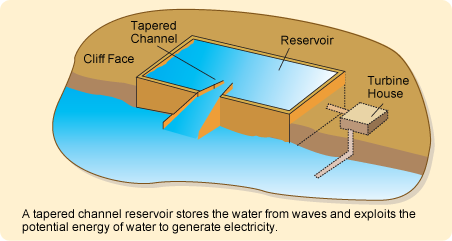ENERGY
Wave Energy
Waves are formed by the wind blowing over the surface of the ocean. In many areas of the world, the wind blows with enough consistency and force to provide continuous waves.
Waves contain both kinetic and potential energies. The kinetic energy is related to the velocity of the movement of water, and the potential energy is a function of the amount of water displaced from the mean sea level.
There are several ways to harness wave energy. The motion of the waves can be used to push and pull air through a pipe. The air spins a turbine in the pipe, producing electricity. Another way to produce energy is to bend or focus the waves into a narrow channel, increasing their power and size. The waves then can be channeled into a catch basin, like tidal plants, or used directly to spin turbines.
There are wave-energy devices that power the lights and whistles on buoys. Small, on-shore sites have the best potential for the immediate future, especially if they can also be used to protect beaches and harbours. They could produce enough energy to power local communities.

















